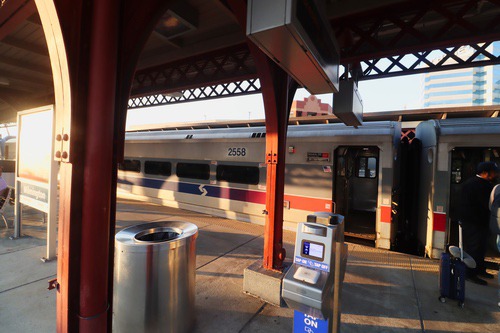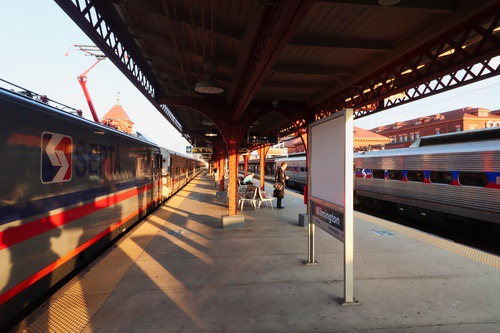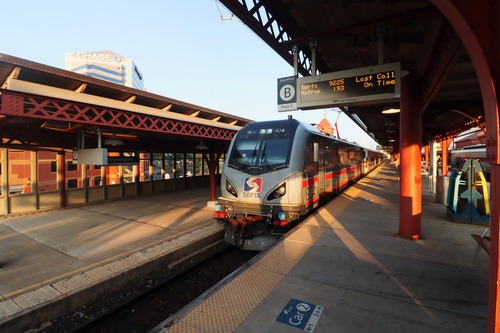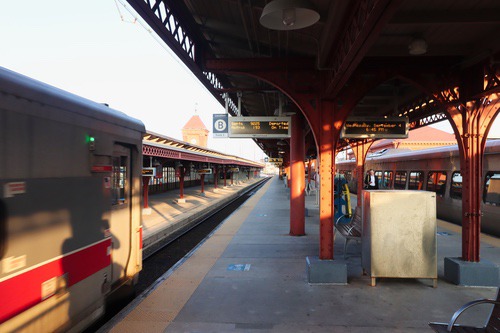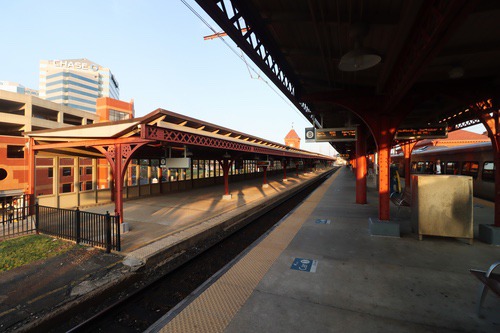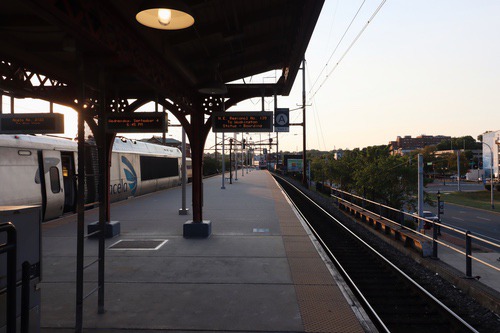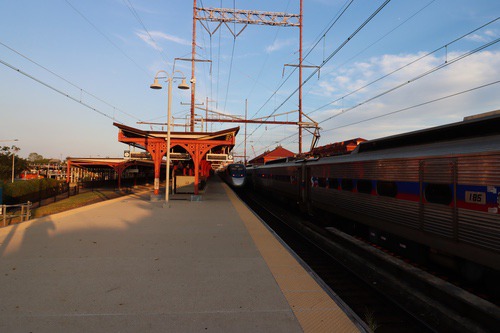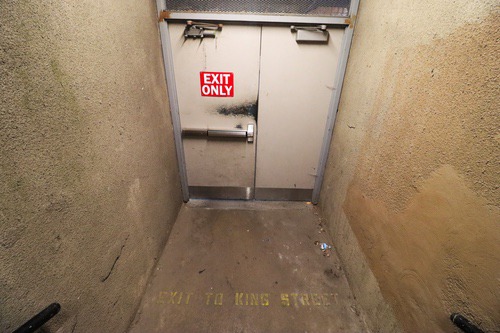



 Newark, DE Newark, DE | Northeast Regional | Philadelphia, PA - 30th Street Station  |
 Baltimore, MD Baltimore, MD | Acela Express | |
| Vermonter | ||
| Carolinian | ||
| Crescent | ||
| Palmetto | ||
| Silver Meteor | ||
| Cardinal |
The Wilmington, DE Amtrak and SEPTA Regional Rail Station is officially the Joseph R. Biden Jr. Railroad Station. It got this honorary name after a large restoration in 2011 after the then Vice President “Amtrak Joe”, who famously was a daily commuter on Amtrak from this station to Washington, DC for most of his time the senator from 1973 to 2009. The station was also where Joe Biden announced his unsuccessful 1987 presidential bid.
The station has always been an important stop on the Northeast Corridor. All Acela Express, and Northeast Regional Trains stopping at the station, along with all long-distance trains along the Northeast Corridor that also receive baggage service at Wilmington. Only occasionally have super express Metroliners or Acela Express trains (generally also skipping Philadelphia) have skipped this station.
Regional Rail service to and from the station hasn't seen continuous operations. This is because of the complicated politics of running commuter service over the state line. In 1983, when SEPTA took over commuter rail service from Conrail all commuter rail service ended in Delaware, with trains now terminating at Marcus Hook. Service was re-extended to Wilmington on January 16, 1989. Today a few early morning, late evening and midday trains still terminate at Marcus Hook, with service into Delaware being only every two hours (all weekend service runs to Wilmington, when all service operates only every two hours). Service was extended father into Delaware (funded by DelDOT via DART First State) down the Northeast Corridor on September 2, 1997, to Newark. Today eight round-trip weekday SEPTA trains make an intermediate stop at Wilmington during rush hours in both directions.
The station is a historic station designed by renowned architect Frank Furness and the exterior makes very good use of the fact that trains run on an elevated viaduct through Downtown Wilmington, with it looking like the station encapsules the trains above. The building is a single story under the viaduct with taller two- and three-story sections on each side of the railroad line that cuts through the station on its viaduct on the second story. This makes the station visually striking with red brick walls and windows encompassing the entire sides of the railroad viaduct running through the middle of the station. There is even a clocktower that juts up on the Western Corner of the station at the intersection of French Street and Front Street.
The date of the station's opening, plaques inside the station are in disagreement over. The station was opened on January 28, 1907, according to the plaque for the 2009-2011 renovation (rededicated March 19, 2011) Joseph R Biden Station plaque or completed in 1905 and restored in 1984 under the Northeast Corridor Improvement Project plaque.
Trains stop at the station on one of three tracks, all of which that platform at what are two platforms normally in service. From the north is a northern low-level side platform for Track 3. This platform is no longer in passenger service, although it still has a tactile warning strip, and a long historic canopy with lots of glass windscreens. There are even LED passenger information signs as if the platform is still in service. This platform is the longest platform at the Wilmington Train Station, extending much farther east than the other platforms. In the middle by the station house area are some fully enclosed areas where access down to the station below is still provided (but not in passenger use).
Passengers instead board nearly all Amtrak trains, and many through SEPTA trains at least to Newark, DE via a more modern high-level island platform serving Tracks 3 and 2. This nearly 1,000 foot-long high-level platform (for long-distance trains) contains a red canopy structure over half its length. This canopy structure doesn't date to the station's historic opening but has red beams and a decorated roofline, designed to fit into the historic nature of the exterior of the station. This platform contains a bank of escalators (in both directions), an elevator (at location G as the sign says) and two staircases down to the station's concourse below.
Towards the western (Washington-bound) end of the platform is a flight of stairs down off the platform. These have Down to King Street stenciled in the ground and begin between two SEPTA KEY validators. These steps lead down to a set of Exit Only as the sign says on them doors that open outward to the middle of the underpass of King Street, not looking like doors that passengers should be able to use. There are no handles to allow anyone to enter the station through these doors, all must enter through the station house concourse. There is also a path that leads to steps to a locked gate off the viaduct from the unused northern low-level side platform.
The third, southernmost track 1 is mainly used by SEPTA trains terminating, and laying over in the Wilmington Station. This was entirely a low-level platform (if my memory serves me correctly) in 2013. Today this is a high-level platform for its westernmost three cars with a ramp leading up from the eastern end of the low-level platform alongside the start of the high level platform. This begins just beyond the historic station house with the platform canopy clearly looking different. The short length of this platform means the back of originating SEPTA trains extend beyond the end of the high-level portion of the platform with not all doors able to open. The low-level portion of the platform is signifigantly longer than the other platforms extending all the way to crossing over Poplar Street, it's not quite as long as the unused northern side platform.
To leave this platform, all access is via the low-level platform portion inside the historic three-story station house. There were once waiting rooms directly along this platform. These have been turned into Amtrak-owned (not in public use) offices and have been named the Capitol Limited, Crescent and Downeaster office suites. To actually leave the platform doors lead into a small indoor waiting area (with a couple of benches). These lead to a grand staircase where two staircases on either side lead down to one grand staircase at an intermediate landing into the station's concourse below. There is also a separate elevator and a separate always-up only escalator that leads up to this low-level platform through its own little portal.
The Concourse level feels a little dark and dreary, with the signs of the 1980s renovation removing anything historic from its interior. The walls are generic grey with an accent of blue paneling. There are restrooms, a news cafe, separate Amtrak and SEPTA Key Card ticket offices. Both Enterprise and Budget car rental offices at one end of the waiting room. There is also Interoperative panels discuss Wilmington's Railroad Heritage. A few benches are available for waiting passengers. There is even a small unattended first class/VIP waiting room with a sign to get the code to the waiting room from the ticket office (I guess I will need to board a train in first class from this station at some point to be able to visit this waiting room).
The statin building contains three entrances. The main entrance is at the corner of French and Front Street. Here stairs lead up into the station, along with a ramp that is the only wheelchair accessible entrance into the station. There are two additional stair access only entrances. These are out to front street, out to the passenger pick-up and drop-off area along Front Street, complete with a canopy extending over the sidewalk from the depot. The final entrance is along the underpass of French Street under the railroad viaduct above. Along these entrance steps is Wilmington Station Art by Joyce Kozloff, competed 1984. These are ceramic tiles handcrafted and painted by the artists using design motifs from the late Victorian period when the station was built. There are remnants of an original forth entrance from the driveway between French Street (where it curves and becomes Rosa Parks Drive) and Walnut Street.
The station building also contains an Amtrak police station precent with some of the most aggressive police offices I've witnessed in my years of visiting railroad stations. Do not visit this station to photograph trains without having a ticket to ride one. I first witnessed the police quite aggressively kicking out an unhoused individual who had wondered up to the platform. This was followed by the police approaching me and asking what I was doing, I showed them my SEPTA Key Card and explained that I knew Amtrak's rules (that platforms are for ticketed passengers only) and they let me go on my way and continue my photo essay since I was there to catch a train. Had I just been wandering around the station taking pictures I feel like I would have gotten a fine for loitering.
Surrounding the station is parking garage heaven. There are three parking garages surrounding the station. The main station is across from East Front Street park, a one full block city park between the station and office buildings (mainly for banks, because of Delawares favorable tax laws) of Downtown Wilmington. On each side of this park (across from Street from the station) are two parking garages. To the west, along French Street is a large five-story parking garage. Just outside this parking garage (with buses boarding on the street) is Wilmington's Intercity Bus (including Greyhound) station.
To the east across Walnut Street from the station, is the Wilmington Transit Center, that was dedicated in March 2020. It contains the main DART First State bus transfer center for Downtown Wilmington on the first-level with two-levels of parking on top of the buses. Although putting bus stations beneath parking garages often feels dingy and dark and not inviting to bus passengers, the ceilings are high enough, and columns aren't very numerous making it more airy than some other transit center examples I have visited. Some bus routes will drop passengers off directly outside the train station, with this bus route saying to cross the street to board buses inside the Wilmington Transit Center.
The third parking garage is directly alongside the western end of the station. This three-story parking deck provides nice views across Tubman Garrett Riverfront Park and the Christina River a block south of the station. The garage blocks all views from the train platforms to the River, with train passengers having the wonderful view parking garages from the station platforms.
Photos 1-104: September 4, 2013; 105-160: January 17, 2025;
